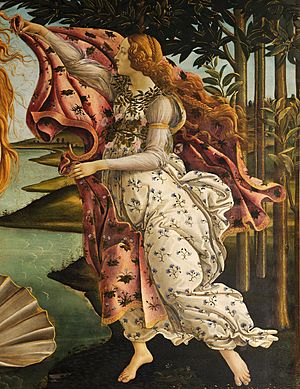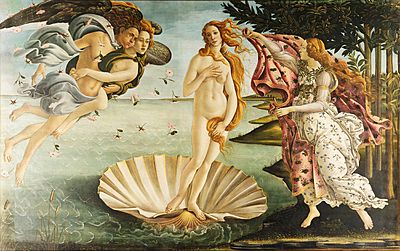The Birth of Venus (Botticelli) facts for kids
The Birth of Venus is a painting by Sandro Botticelli (1445 – May 17, 1510). It is of a Roman goddess who was called Venus. He pictured her standing on a shell because Venus was said to have been born from foam on the sea in Stanze per la giostra, a poem written by Angelo Poliziano. The painting shows Zephyr, god of the winds holding the gentle breeze Aura, blowing her toward the shore where Horae, goddess of the seasons, is awaiting her with a cloak. She is pictured naked to show her innocence and divinity.
Description and subject

In the centre, the newly born goddess Venus stands in a giant scallop shell. The size of the shell is purely imaginary, and is also found in classical depictions of the subject. At the left the wind god Zephyrus blows at her, with the wind shown by lines radiating from his mouth. He is in the air, and carries a young female, who is also blowing, but less forcefully. Both have wings. Vasari was probably correct in identifying her as "Aura", personification of a lighter breeze. Their joint efforts are blowing Venus towards the shore, and blowing the hair and clothes of the other figures to the right.
At the right a female figure who may be floating slightly above the ground holds out a rich cloak or dress to cover Venus when she reaches the shore, as she is about to do. She is one of the three Horae or Hours, Greek minor goddesses of the seasons and of other divisions of time, and attendants of Venus. The floral decoration of her dress suggests she is the Hora of Spring.She stands in a contrapposto pose, similarly to Venus as she seems relaxed and joyful that Venus has arrived.
Alternative identifications for the two secondary female figures involve those also found in the Primavera; the nymph held by Zephyr may be Chloris, a flower nymph he married in some versions of her story, and the figure on land may be Flora. Flora is generally the Roman equivalent of the Greek Chloris; in the Primavera, Chloris is transformed into the figure of Flora next to her, following Ovid's Fasti, but it is hard to see that such a transformation is envisaged here. However, the roses blown along with the two flying figures would be appropriate for Chloris.
The subject is not strictly the "Birth of Venus", a title given to the painting only in the nineteenth century (though given as the subject by Vasari), but the next scene in her story, where she arrives on land, blown by the wind. The land probably represents either Cythera or Cyprus, both Mediterranean islands regarded by the Greeks as territories of Venus.
Dating and history
It has long been suggested that Botticelli was commissioned to paint the work by the Medici family of Florence, perhaps by Lorenzo di Pierfrancesco de' Medici (1463–1503) a major patron of Botticelli, under the influence of his cousin Lorenzo de' Medici, "il Magnifico". This was first suggested by Herbert Horne in his monograph of 1908, the first major modern work on Botticelli, and long followed by most writers, but more recently has been widely doubted, though it is still accepted by some. Various interpretations of the painting rely on this origin for its meaning. Although relations were perhaps always rather tense between the Magnifico and his young cousins and wards, Lorenzo di Pierfrancesco and his brother Giovanni di Pierfrancesco de' Medici, it may have been politic to commission a work that glorified the older Lorenzo, as some interpretations have it. There may be a deliberate ambiguity as to which Lorenzo was intended to be evoked. In later years hostility between the two branches of the family became overt.
Horne believed that the painting was commissioned soon after the purchase in 1477 of the Villa di Castello, a country house outside Florence, by Lorenzo and Giovanni, to decorate their new house, which they were rebuilding. This was the year after their father died at the age of 46, leaving the young boys wards of their cousin Lorenzo il Magnifico, of the senior branch of the Medici family and de facto ruler of Florence. There is no record of the original commission, and the painting is first mentioned by Vasari, who saw it, together with the Primavera, at Castello, some time before the first edition of his Lives in 1550, probably by 1530–40. In 1550 Vasari was himself painting in the villa, but he very possibly visited it before that. But in 1975 it emerged that, unlike the Primavera, the Birth is not in the inventory, apparently complete, made in 1499 of the works of art belonging to Lorenzo di Pierfrancesco's branch of the family. Ronald Lightbown concludes that it only came to be owned by the Medici after that. The inventory was only published in 1975, and made many previous assumptions invalid.
Horne dated the work at some point after the purchase of the villa in 1477 and before Botticelli's departure for Rome to join the painting of the Sistine Chapel in 1481. Recent scholars prefer a date of around 1484–86 on grounds of the work's place in the development of Botticelli's style. The Primavera is now usually dated earlier, after Botticelli's return from Rome in 1482 and perhaps around the time of Lorenzo di Pierfrancesco's wedding in July 1482, but by some still before Botticelli's departure.
Whenever the two paintings were united at Castello, they have remained together ever since. They stayed in Castello until 1815, when they were transferred to the Uffizi. For some years until 1919 they were kept in the Galleria dell'Accademia, another government museum in Florence.
Style
Although the pose of Venus is classical in some respects, and borrows the position of the hands from the Venus Pudica type in Greco-Roman sculptures (see section below), the overall treatment of the figure, standing off-centre with a curved body of long flowing lines, is in many respects from Gothic art.
See also
 In Spanish: El nacimiento de Venus (Botticelli) para niños
In Spanish: El nacimiento de Venus (Botticelli) para niños



